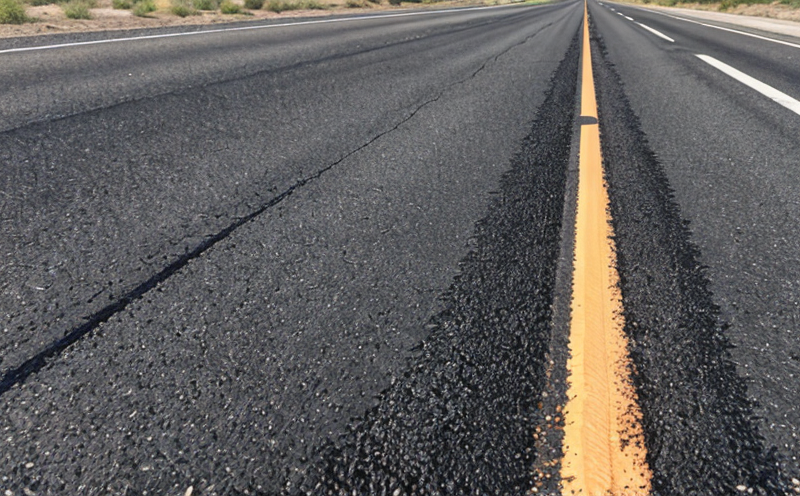ISO 12697 Indirect Tensile Resilient Modulus
The indirect tensile resilient modulus (MR) test per ISO 12697 is a crucial method for evaluating the mechanical properties of asphalt and pavement materials. This test measures the material's ability to absorb energy during deformation, which is essential for understanding the long-term performance of road pavements under traffic loads.
The MR value provides insights into how asphalt mixtures will behave over time in real-world conditions. The test involves applying a cyclic tensile load at a constant rate until the material reaches its peak strain. During this process, the resilient modulus is determined by analyzing the energy absorbed during each cycle of loading and unloading.
Understanding MR helps predict the fatigue life of pavements, ensuring that they can withstand heavy traffic loads without excessive deformation or cracking. The test is particularly important for quality assurance in new pavement construction and for monitoring the condition of existing roadways over time.
The ISO 12697 method is widely recognized as a reliable means to assess asphalt mixtures' performance, especially when combined with other tests like those specified in ASTM D4541. For R&D engineers, this test provides critical data for optimizing mixture designs and developing new materials that can enhance pavement durability.
Quality managers and compliance officers rely on MR testing results to ensure their projects meet stringent quality standards and regulatory requirements. The test is also valuable during the procurement process, as it helps specify the quality of asphalt products that are being considered for a project.
The indirect tensile resilient modulus test requires precise instrumentation and careful specimen preparation. Specimens must be carefully prepared to ensure they accurately represent the material's properties under test conditions. The testing apparatus typically includes hydraulic loading systems capable of applying controlled cyclic loads, strain gauges to monitor deformations, and data acquisition systems to capture all relevant parameters.
The standard procedure involves preparing cylindrical specimens from the asphalt mixture samples. These specimens are then subjected to a series of tensile cycles under specified conditions. The MR is calculated based on the energy absorbed during these cycles, which reflects the material's resilience to deformation.
Why It Matters
The results from ISO 12697 testing are vital for several reasons. Firstly, they provide critical data on the long-term performance of asphalt pavements under cyclic loading conditions. This information is essential for predicting the fatigue life and durability of roadways, which directly impacts maintenance costs and overall pavement sustainability.
Secondly, MR testing helps in optimizing asphalt mixture designs by identifying materials that offer superior resilience to deformation without compromising on other important properties like strength or workability. This optimization process ensures that pavements are not only durable but also cost-effective to construct and maintain.
The test results are also crucial for compliance with international standards, such as ISO 12697-1, which sets out the procedure for conducting indirect tensile resilient modulus tests. Compliance is necessary for ensuring that projects meet regulatory requirements and industry best practices, thereby protecting both public safety and environmental integrity.
Furthermore, MR testing results can inform decisions on pavement rehabilitation and reconstruction. By understanding how existing pavements are performing based on MR values, engineers can make informed choices about when and where to apply maintenance or replacement strategies. This proactive approach helps in extending the useful life of roadways and reducing the need for frequent repairs.
For quality managers and compliance officers, MR testing results provide a robust basis for ensuring that all materials and processes meet the required standards. This not only enhances project success but also builds trust with stakeholders by demonstrating a commitment to excellence in pavement construction and maintenance.
Applied Standards
| Standard Name | Description |
|---|---|
| ISO 12697-1:2018 | Specification for the determination of resilient modulus by indirect tensile test. |
| ASTM D4541 | Standard practice for preparing specimens of bituminous paving mixtures and pavements from cores or cutouts. |
| EN 13728:2006 | Methods of testing asphalt binders, mixes and pavements - Determination of resilient modulus by indirect tensile test. |
| IEC 61954 | Power quality and energy measurement - General aspects. |
Use Cases and Application Examples
The indirect tensile resilient modulus test is widely used in various applications, particularly in the testing of asphalt mixtures. One common use case involves the evaluation of new pavement materials for construction projects. By conducting MR tests on samples from different mixture designs, engineers can compare the performance characteristics and select the most suitable material for a specific project.
In existing infrastructure maintenance programs, MR testing is employed to monitor the condition of roadways over time. This helps in identifying areas where further investigation or repair might be necessary. For instance, if an MR test indicates that a particular section of pavement is degrading faster than expected, it could signal the need for early intervention.
The test also finds application in research and development (R&D) environments. Researchers use MR testing to explore new binder formulations or aggregate types that can enhance the performance of asphalt mixtures under various environmental conditions. This can lead to innovations that improve both the durability and sustainability of road pavements.
Another practical example is in the procurement process for asphalt products. Contractors often request MR test results from suppliers as part of their quality assurance checks. By comparing these results against specified criteria, they can select reliable and high-quality materials for construction projects.
| Use Case | Description |
|---|---|
| New Pavement Construction | Evaluating the performance characteristics of new asphalt mixtures. |
| Infrastructure Maintenance | Monitoring the condition of existing roadways to inform maintenance and repair decisions. |
| R&D Innovation | Exploring new binder formulations or aggregate types that enhance performance. |
| Procurement Quality Assurance | Selecting reliable and high-quality asphalt materials for construction projects. |





